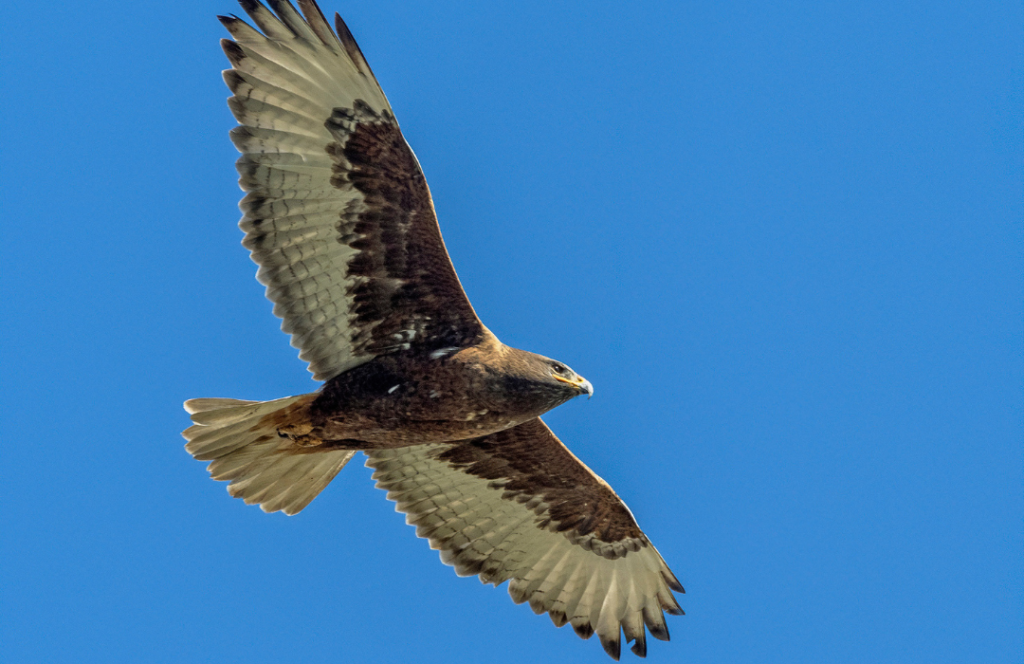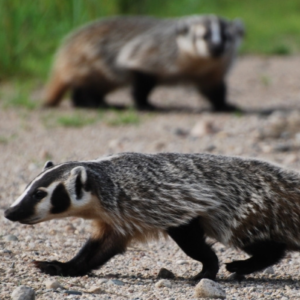Ferruginous Hawk
Believe it or not, this large bird spends a lot of time on the ground hunting and nesting. Save endangered species today by joining one of our campaigns!
Help End the ExtinctionVital Signs
- Common name: Ferruginous Hawk
- Latin name: Buteo regalis
- Conservation Status: Threatened
- Range: Alberta, Saskatchewan, Manitoba
- Lifespan: 20 years or more. The oldest recorded age is 23 years and 8 months
- Size: Wingspan of 133-142 cm, head-to-talon length of 56-69cm, weight of 0.97-2.1kg. Females are larger

The Ferruginous Hawk comes in a light and dark colouration. The light colouration has a white belly, while the dark colouration is a dark brown on its back and stomach. Both have white on the underside of their wings. The light colouration also has a brown-feathered “V” along the underside of its legs and tail.
Ferruginous Hawk Facts
- Eats mainly rodents, but will eat what’s available, including: small to medium-sized mammals, smaller birds, snakes, and large insects
- Is the largest hawk in North America
- Catches prey by using the “sit-and-wait” method – they wait on the ground outside the prey’s den
- Courtship involves dancing in the sky, diving on the part of the male, and the pair spiralling towards the ground holding each other’s beaks and talons
- Use things like sticks, shrubs, shredded bark, and cow dung to make nests. In the past, they also used bison hair and bones
- Its name, “ferruginous,” refers to the hawk’s rusty colouring

Threats
The Ferruginous Hawk population in North America is now only a quarter of what it was in the early 1900’s, and its range is only half of what it was in the past. The loss of and fragmentation of its habitat, native grasslands, are a serious threat to the population. Ferruginous Hawks also suffer from a lack of nest sites as more and more trees are cut down in their habitat.
They are also threatened by human activity and the loss of prey, particularly Richardson’s ground squirrel.
What’s Being Done
The species is protected by the Canada National Parks Act in the Grasslands National Park of Canada. It is also protected under Alberta’s Wildlife Act and the Manitoba Endangered Species Act.
Alberta has the Alberta Ferruginous Hawk Recovery Plan 2009-2014 in place. This focuses on habitat preservation, reducing human disturbances and human-caused mortality, population monitoring, outreach, and research. Manitoba is also monitoring the Ferruginous Hawk with their Threatened Grassland Bird Project.

Canada has committed to the goal of protecting 30% of lands, ocean, and freshwater in Canada by 2030. This goal will help protect ecosystems, restore habitats, and fight climate change. All these things are a step in protecting Canada’s at-risk animals—so let’s hold the federal government to their promise.
How to Help
- Help Out: Alberta has brochures on how to create a nesting habitat for Ferruginous Hawks. check out this PDF!
- Learn: Stay informed about endangered species by signing up for Nature Canada’s monthly e-newsletter.
- Find out more: Help us end the extinction by taking action for nature today—visit conservation websites like Nature Canada or join one of our campaigns!
Resources:
- Alberta Ferruginous Hawk Recovery Plan 2009 -2014
- The Cornell Lab – All About Birds: Ferruginous Hawk
- COSEWIC – Assessment and Status Report
- Government of Manitoba – Ferruginous Hawk
- SARA – Species Profile



